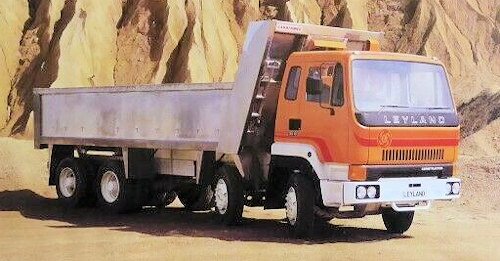Leyland Constructor
 | |
Manufacturer: | Leyland Trucks |
Type: | Commercial vehicle |
Designation: | Constructor.Leyland DAF 60 / DAF 60 |
Production period: | 1981 to 1993 |
Engines: | Leyland TL11 6-cylinder diesel engine with 181 hp, 209 hp, 260 hp |
Power: | 133-243 kW |
Payload: | 10-30 t |
The Leyland Constructor first built in 1981 by Leyland Trucks and later Leyland DAF until 1993.
History
The Leyland Constructor was the second model from British Leyland Motor Corporation based on the T45 Project. The construction vehicle was built mainly as a dump truck and replaced the model series Leyland Bison and Leyland Buffalo . Following the merger of Leyland Motors and DAF into Leyland DAF , the Leyland Constructor was marketed in 1990 as the Leyland DAF 60 in the United Kingdom and as DAF 60 in Continental Europe.
The Leyland Constructor was available as a construction vehicle ina 6x2.6x4, 8x2, 8x4 and 8x8 drive format. However, it also existed for the transport of goods with box body body . All versions had a payload between 10 and 30 tons. As with the Leyland Roadtrain with the T45 driver's cab in normal design or as a double cabin with sleeping facilities and optionally with a high roof. Basically with the same equipment of the cabin but here the cabin floor was equipped with thick padded rubber instead of a carpet and optional there were vinyl seat covers instead of fabric covers. From its predecessors Leyland Bison & Buffalo the Constructor took over the chassiswith the exception of the foremost section of the ladder frame due to the connections with the new T45 cab. Also, the brake system was adopted, which was introduced only in the predecessors in recent years, but again improved. The tandem rear-drive axles with hub reduction gear used in principle also came from its predecessors, but were adapted due to the higher requirements and performance capabilities of the engines. This caused damage to the drive shafts in the first years of construction at particularly high load, as well as insufficiently designed radiator protection in the 6x version caused problems. Leyland quickly eliminated these sources of error and changed the designs.
Also with the Leyland Bison the revolutionary but initially unreliable direct-injection diesel engine Leyland 500 OHC was originally installed. But after BLMC upgraded it to the Leyland 0-680 and used it as a LIS & TL11 in the Bison, the Bison, which was outdated in terms of design and comfort, offered technical reliability like the other models equipped with the engine family. Therefore, it was not surprising that the relatively new TL11 6-cylinder diesel engine, which had high torque, was now taken on the Constructor with 181 hp or 209 hp. For the 8x variant, there was also a Rolls-Royce 220 hp or the Gardner 6LXC-T with 230 hp diesel engine. The power transmission took place in each case with theEaton 400 manual transmission. For heavier tasks there was a Fuller 9-speed for the 6x and a Spicer 10-speed manual transmission for the 8x . In 1985, the engine range was revised. The Leyland TL11 now offered 260 hp and the 8x version could also be ordered with a Perkins Engines or Cummins Engine 300 hp diesel engine. This made the 30:30 Constructor the strongest dump truck in the world for some time. To cope with the extra power and reduce production costs, the twin rear axles still on an Albion construction were replaced on the 30:30 by those supplied by Eaton.
Through the merger with Leyland DAF , the constructor was now marketed as Leyland DAF 60 in the UK and DAF 60 in continental Europe during 1990 . Now there was only the DAF ATI 11.6 liter diesel engine with 300 or 330 hp, which was itself an evolution of the Leyland 0-680 with an Eaton 12-speed split transmission.
By the end of 1993, the series was produced and replaced in 1994 by the DAF 85 .
Rating
Manuals
- Leyland Motors Ltd Previous 6 / 40 Next




